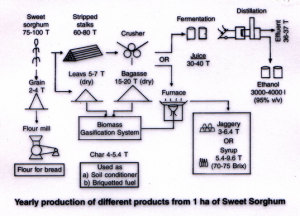Fermentation of Sweet Sorghum to Form Ethanol
Stalks of sweet sorghum contain fermentable sugars in the sap equal to 400-600 gallons of ethanol per acre or about twice that from corn grain. Sweet sorghum is the crop that communities used to grow to make sorghum syrup (molasses). Sweet sorghum has been grown for many years in the southeastern United States in small plantings for making sweet syrup. Plant breeders have developed high sucrose cultivars to increase the potential of this crop as a sucrose source. This effort has also made sweet sorghum a candidate feedstock for the production of ethanol. Ethanol is added to gasoline to increase the octane rating, reduce pollution, and extend the gasoline supply for internal combustion engines. The sugars synthesized by sweet sorghum, Sorghum bicolor (L.) Moench, are stored in stems (culms) as is the case with sugarcane. Sugarcane, however, requires 12 to 24 months of tropical climate to mature, whereas sweet sorghum can be grown to maturity in 92 to 180 days. It thus can be grown successfully during the warm season of a temperate climate. To produce alcohol, the juice must be pressed from the sweet sorghum stems and fermented. The alcohol is then distilled from the fermentation vat. Bagasse, the residual stalk material, can be used as fuel for the distillation process. At maturity, sweet sorghum produces heads (panicles) bearing seeds. The seed crop is relatively small and is of minor importance in furnishing carbohydrate for fermentation or for use as animal feed. For most cultivars, stalk sugar concentration increases from the milk stage to the soft dough stage of the seed, then declines as the seeds become more mature. Research at the University of California, Davis, has shown that sweet sorghum has characteristics that favor its use for the production of alcohol. It produces about 23% more fermentable carbohydrate than does field corn, requires only 37% of the fertilizer nitrogen used by corn, and requires about 17% less irrigation water.
Flow Diagram

(Source: http://www.google.com/imgres?imgurl=http://www.nariphaltan.org/nari/image_files/ethanol%2520yearly%2520data.jpg&imgrefurl=http://www.nariphaltan.org/nari/technology_agri_2_sorghum.php&h=965&w=1340&sz=266&tbnid=sRYJdh2BIW2FjM:&tbnh=77&tbnw=107&zoom=1&usg=__jziMJiq0GJtRBy8nXCFHy4BKYGU=&docid=0rahPv8EmhIXnM&hl=en&sa=X&ei=SDcXUeuwJIGi8QSom4GACw&ved=0CHgQ9QEwCw&dur=263)
Equipment
Video Links
Sweet Sorghum for Biofuel (University of Missouri)
References
- http://www.google.com/imgres?imgurl=http://www.nariphaltan.org/nari/image_files/ethanol%2520yearly%2520data.jpg&imgrefurl=http://www.nariphaltan.org/nari/technology_agri_2_sorghum.php&h=965&w=1340&sz=266&tbnid=sRYJdh2BIW2FjM:&tbnh=77&tbnw=107&zoom=1&usg=__jziMJiq0GJtRBy8nXCFHy4BKYGU=&docid=0rahPv8EmhIXnM&hl=en&sa=X&ei=SDcXUeuwJIGi8QSom4GACw&ved=0CHgQ9QEwCw&dur=263
- http://www.iowaenergycenter.org/ethanol-from-sweet-sorghum/
- http://ucce.ucdavis.edu/files/repositoryfiles/ca4401p14-69434.pdf
- http://www.thefreedictionary.com/cultivar
- http://en.wikipedia.org/wiki/Octane_rating
- http://encyclopedia2.thefreedictionary.com/Fermenting+Vat
- http://www.thefreedictionary.com/bagasse
- http://youtu.be/OHM8_Wb4igg